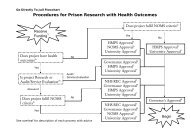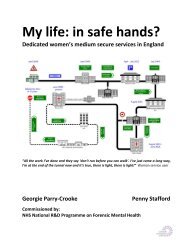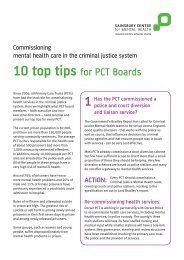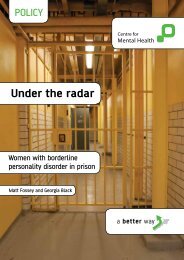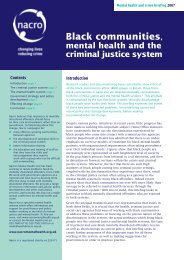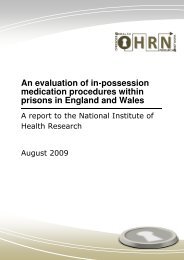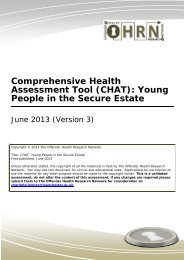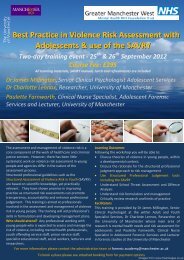Engendering Justice - from Policy to Practice - The Fawcett Society
Engendering Justice - from Policy to Practice - The Fawcett Society
Engendering Justice - from Policy to Practice - The Fawcett Society
- No tags were found...
You also want an ePaper? Increase the reach of your titles
YUMPU automatically turns print PDFs into web optimized ePapers that Google loves.
her career, as these women may find it harder <strong>to</strong> meet therequirements for judicial and other references. <strong>The</strong> cost ofthe Silk application may also preclude some women withthe application fee for the third competition currently £2,500plus VAT and a further fee of £3,500 plus VAT payable bysuccessful applicants on appointment.…When I was at the bar I did feel that I was discriminatedagainst. After having my first child I returned <strong>to</strong> chamberson a part time, three days a week basis. After I had mysecond child, when I came back <strong>from</strong> maternity leave theclerks had done absolutely nothing <strong>to</strong> get me any work(they had not even written <strong>to</strong> solici<strong>to</strong>rs <strong>to</strong> tell them that Iwas returning, although the date had been fixed for somemonths). I complained about this but little was done. I thenrequested <strong>to</strong> be allowed <strong>to</strong> pay my chambers rent on a prorata basis as I was only in three days a week but receivedthe response that my desk was available <strong>to</strong> me five days aweek and there was no reason why members of chambersshould have <strong>to</strong> subsidise me because I choose <strong>to</strong> stay athome for some of the time. I left practice shortly thereafter.My general experience at the Bar was that there appeared<strong>to</strong> be no discrimination against women who did not havechildren, or who did have children but were prepared <strong>to</strong>return <strong>to</strong> work without making any adjustment <strong>to</strong> the wayin which they worked, but those who wished <strong>to</strong> work parttime,or had geographical or time restrictions because oftheir childcare commitments, were effectively written off.Former Female Barrister, Questionnaire Response,February 2009Women are also often pigeonholed in<strong>to</strong> practising within thestereotypically ‘acceptable’ areas for women, such as familylaw. As one woman <strong>to</strong>ld the Commission, “my clerk…pushed me in<strong>to</strong> family work when my background was civil/commercial.” 229<strong>The</strong> Commission supports the recommendation madeby the Entry <strong>to</strong> the Bar Working Committee in relation<strong>to</strong> retention, including that equality and diversity trainingshould be made compulsory for all barristers as part of theircontinuing professional development requirements andthat a men<strong>to</strong>ring policy, particularly for women who takematernity leave or career breaks, is adopted by Chambersand relevant employers. 230<strong>The</strong> Courts and theJudiciary<strong>The</strong> lack of diversity in the Judiciary has remained a majorconcern for the Commission since its inception. <strong>Justice</strong>needs <strong>to</strong> be accessible and responsive <strong>to</strong> all citizens,irresponsive of gender. As Lady Brenda Hale, the firstfemale Judge <strong>to</strong> be appointed <strong>to</strong> the House of Lords, whenasked about the lack of female judges, commented:This matters because democracy matters . . . We arethe instrument by which the will of the Parliament andGovernment is enforced upon the people. . . Judgesshould be no less representative than the politicians andcivil servants who govern us. 231Judges should more accurately reflect the diversity ofsociety in order <strong>to</strong> ensure that there is public confidencein the system particularly <strong>from</strong> the female population.Further, women can bring new and unique perspectives<strong>to</strong> the bench based on their experiences, concerns andinterests. As Lady <strong>Justice</strong> Arden, stated in her address <strong>to</strong>the Association of Women Barristers “It is that potentialfor different perspectives that men and women often havethat in my view has the potential <strong>to</strong> enrich judicial decisionmaking.”232In April 2008, of the 3820 Judges in England and Wales,just under 20 percent were women. 233 <strong>The</strong> EHRC report in<strong>to</strong>Sex and Power in 2008, revealed that women representedonly 9.6 percent of the senior judiciary (high court judgeand above) and that at this current rate of progress itwould take another 55 years <strong>to</strong> achieve an equal numberof senior female and male judges. 234 According <strong>to</strong> the mostrecent figures currently available, just over ten percent ofthe 109 High Court Judges are women and just over eightpercent of the 37 Court of Appeal Judges are female. 235This represents particularly poor progress, especially incomparison <strong>to</strong> the proportion of female judges in otherinternational senior courts (see Table Six). As <strong>Justice</strong> LadyArden stated:<strong>The</strong>re are far fewer woman Judges in England and Walesthan in many other jurisdictions throughout the world... 236Page 73




